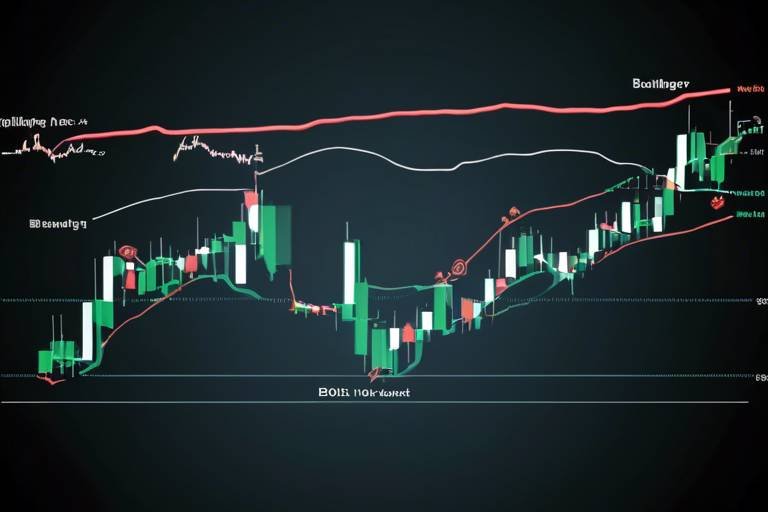Mastering Swing Trading - Tips for Cryptocurrency Investors
In the ever-evolving world of cryptocurrency, mastering the art of swing trading can be a game changer for investors looking to maximize their profits. Swing trading is not just about making quick trades; it's about understanding market trends, timing your entries and exits, and capitalizing on price fluctuations. Imagine yourself as a surfer, waiting patiently for the perfect wave to ride. That's what swing trading is all about—finding that ideal moment to jump in and ride the market's momentum.
For many investors, the allure of cryptocurrency lies in its volatility. Prices can soar and plummet in the blink of an eye, creating opportunities for those who know how to navigate these waters. However, without a solid strategy, the same volatility can lead to significant losses. That's where swing trading comes into play. By holding onto assets for a few days or weeks, traders can take advantage of short-term price movements while avoiding the stress of day trading.
One of the most rewarding aspects of swing trading is its flexibility. Unlike day trading, which requires constant monitoring of the markets, swing trading allows you to step back and evaluate your trades without feeling the pressure of immediate decisions. It's like taking a leisurely stroll through a beautiful garden instead of sprinting through a crowded mall. This approach not only reduces stress but also provides ample time for analysis and strategy refinement.
As we delve deeper into this article, we will explore effective strategies and tips that can help you become a successful swing trader in the cryptocurrency market. From understanding key indicators to implementing robust risk management techniques, we will cover everything you need to know to enhance your trading skills. So, buckle up and get ready to ride the waves of the crypto market with confidence!
Swing trading is a trading style that focuses on capturing short- to medium-term gains in a stock (or cryptocurrency) over a period of a few days to several weeks. The primary goal is to identify potential price swings and capitalize on them. Think of it as a dance with the market—following its rhythm and anticipating its next move.
One of the biggest advantages of swing trading is the ability to make profits without needing to monitor the markets 24/7. This is particularly beneficial for those who have other commitments, such as a full-time job or family responsibilities. By focusing on the larger price movements rather than minute-to-minute fluctuations, swing traders can make informed decisions that align with their lifestyle.
Additionally, swing trading allows investors to take advantage of both upward and downward trends. By employing various strategies, traders can profit from rising markets as well as falling ones. This duality is essential in the crypto market, where prices can be unpredictable. In the following sections, we will dive into the key indicators and strategies that can help you excel in swing trading.
When it comes to swing trading, having the right tools at your disposal is crucial. Identifying key indicators can help you make informed decisions and enhance your trading strategies. In the volatile world of cryptocurrency, these indicators act as your compass, guiding you through the unpredictable waters of the market.
Moving averages are one of the fundamental tools in swing trading. They help smooth out price data and provide a clearer view of the market trend. By analyzing moving averages, traders can identify potential entry and exit points. There are two main types of moving averages that swing traders often use: simple moving averages (SMA) and exponential moving averages (EMA).
Understanding the differences between these moving averages is essential for developing effective trading strategies:
| Type | Description |
|---|---|
| Simple Moving Average (SMA) | Averages the price over a specific number of periods, providing a smooth line that represents the trend. |
| Exponential Moving Average (EMA) | Gives more weight to recent prices, making it more responsive to new information and trends. |
| Weighted Moving Average (WMA) | Similar to EMA but assigns different weights to prices, allowing for a more customized approach. |
Choosing the right periods for moving averages can significantly impact your trading decisions. Generally, shorter periods are more sensitive to price changes, while longer periods provide a broader view of the trend. For example, a 10-day moving average might be suitable for short-term trading, while a 50-day moving average could be better for more extended trends. The key is to align your moving average periods with your trading style and the current market conditions.
Recognizing chart patterns is vital for predicting price movements. Just like reading the stars can guide sailors at sea, understanding chart patterns can help traders navigate the crypto market. Some common patterns to look for include:
- Head and Shoulders
- Double Tops and Bottoms
- Triangles (Ascending, Descending, Symmetrical)
- Flags and Pennants
By identifying these patterns, traders can anticipate potential price movements and make informed decisions about when to enter or exit a trade.
Effective risk management is essential for long-term success in swing trading. It’s not just about making profits; it’s about protecting your capital and minimizing losses. Think of risk management as the safety net that allows you to take calculated risks without jeopardizing your entire investment.
Stop-loss orders are a critical component of risk management. They allow traders to set predetermined exit points for their trades, ensuring that losses are minimized if the market moves against them. Setting effective stop-loss levels requires careful consideration of market volatility and your risk tolerance. It's like having a parachute while skydiving—you want to ensure you're ready for a safe landing if things go awry.
Diversification can mitigate risks in swing trading. By spreading your investments across various cryptocurrencies, you can balance potential gains and losses effectively. This strategy is akin to not putting all your eggs in one basket; it allows you to weather the storms of market volatility while still having the opportunity to catch the big waves.
Q: What is the best time frame for swing trading?
A: Swing traders typically hold positions for a few days to weeks. The ideal time frame can vary based on individual strategies and market conditions.
Q: Do I need to be an expert to start swing trading?
A: While having knowledge of technical analysis and market trends is beneficial, beginners can start swing trading by learning and practicing with smaller amounts.
Q: Can I swing trade in a bear market?
A: Yes! Swing trading can be profitable in both bull and bear markets by identifying short-term price movements and trends.

Understanding Swing Trading
Swing trading is an exciting approach that allows cryptocurrency investors to take advantage of price fluctuations over a short period, typically ranging from a few days to several weeks. Imagine riding the waves of the ocean; swing traders look for those peaks and troughs in the market to catch the best waves for profit. This trading style is all about capturing the momentum of price swings rather than holding assets for the long haul. By understanding market trends and utilizing specific strategies, swing traders can position themselves to maximize their gains while minimizing risks.
One of the key advantages of swing trading in the cryptocurrency market is the ability to capitalize on volatility. Unlike traditional investing, where you might buy and hold an asset for years, swing trading allows you to take advantage of the rapid price changes that are characteristic of cryptocurrencies. This can lead to significant profits in a relatively short timeframe. However, it’s important to remember that with the potential for high rewards comes the possibility of high risks. Therefore, having a solid grasp of swing trading principles is essential for anyone looking to dive into this dynamic trading style.
At its core, swing trading requires a blend of technical analysis, market knowledge, and emotional discipline. Traders often rely on various indicators and chart patterns to make informed decisions. For instance, they might look at moving averages to identify trends or use support and resistance levels to determine potential entry and exit points. By mastering these tools, swing traders can enhance their chances of success in the fast-paced world of cryptocurrency trading.
Moreover, swing trading is particularly appealing for those who may not have the time to monitor the markets constantly. Since trades are held for a few days or weeks, investors can engage in this strategy while balancing other commitments, making it a flexible option for busy individuals. However, it’s crucial to stay updated on market news and trends, as sudden developments can lead to significant price shifts.
In summary, understanding swing trading involves recognizing its unique characteristics and advantages. By embracing this strategy, cryptocurrency investors can harness the potential of market fluctuations to achieve their financial goals. With the right knowledge and tools, swing trading can be a rewarding venture, allowing traders to navigate the exhilarating yet unpredictable waters of the crypto market.

Key Indicators for Swing Trading
Swing trading is all about timing, and to nail that timing, you need to be equipped with the right tools. In the chaotic world of cryptocurrency, where prices can swing wildly within hours, having a solid grasp of key indicators can make all the difference. Think of these indicators as your trusty compass, guiding you through the stormy seas of market fluctuations. By understanding and utilizing these tools, you can make informed decisions that could lead to profitable trades.
One of the most critical aspects of swing trading is identifying the right indicators. These indicators help traders gauge market sentiment, assess price trends, and predict potential reversals. Among the plethora of options available, some stand out as essential for any swing trader's toolkit. Let’s dive into a few that can significantly enhance your trading strategy.
Moving averages (MAs) are fundamental tools in swing trading that smooth out price data to create a trend-following indicator. They help traders identify the direction of the trend and potential reversal points. There are two primary types of moving averages that every swing trader should be familiar with: Simple Moving Averages (SMA) and Exponential Moving Averages (EMA).
Each type of moving average serves a different purpose:
| Type | Description | Best Used For |
|---|---|---|
| Simple Moving Average (SMA) | Averages price data over a specific period. | Identifying long-term trends. |
| Exponential Moving Average (EMA) | Gives more weight to recent prices, making it more responsive. | Capturing short-term price movements. |
| Weighted Moving Average (WMA) | Similar to EMA but with a different weighting scheme. | Focusing on specific price points more heavily. |
By combining these moving averages, traders can create a robust strategy. For instance, using a short-term EMA alongside a long-term SMA can help identify potential buy or sell signals based on crossovers.
Choosing the right periods for moving averages is crucial. Generally, shorter periods (like 5 or 10 days) are more sensitive to price changes, while longer periods (like 50 or 200 days) provide a smoother trend line. The key is to align your moving average periods with your trading style:
- Day traders: Often use shorter moving averages (5-15 days).
- Swing traders: Typically prefer medium-term averages (20-50 days).
- Long-term investors: May focus on longer averages (100-200 days).
By tailoring your moving average settings to your trading approach, you can better capture the market's rhythm and enhance your decision-making process.
Another vital aspect of swing trading is recognizing chart patterns. These patterns can provide insights into potential price movements and help traders anticipate shifts in market sentiment. Some common patterns to look out for include:
- Head and Shoulders: Indicates a reversal trend.
- Double Tops and Bottoms: Signal potential reversals.
- Triangles: Suggest continuation or reversal.
By combining moving averages with these chart patterns, you can create a comprehensive trading strategy that not only reacts to market movements but anticipates them.
Q: What is the best indicator for swing trading?
A: There isn't a one-size-fits-all answer, but moving averages and chart patterns are among the most effective indicators. It's best to use a combination that suits your trading style.
Q: How long should I hold my trades as a swing trader?
A: Typically, swing traders hold positions for several days to weeks, depending on market conditions and individual strategy.
Q: Can I use swing trading strategies in other markets besides cryptocurrency?
A: Absolutely! Swing trading strategies can be applied to various markets, including stocks, forex, and commodities, as the principles of price movement and trend analysis remain consistent.

Moving Averages
When it comes to swing trading in the cryptocurrency market, are your best friends. They serve as a guiding light, helping traders navigate the often turbulent waters of price movements. Think of moving averages as the smooth surface of a lake, reflecting the underlying trends of the market while filtering out the noise created by short-term fluctuations. By averaging price data over a specified period, these tools help you identify the direction of the trend and potential entry and exit points.
There are two primary types of moving averages that swing traders often rely on: Simple Moving Averages (SMA) and Exponential Moving Averages (EMA). The SMA calculates the average price over a set number of days, giving equal weight to all prices within that period. In contrast, the EMA gives more weight to recent prices, making it more responsive to new information. This responsiveness can be crucial in the fast-paced world of cryptocurrency, where a sudden price spike or drop can occur at any moment.
To illustrate the differences between these moving averages, consider the following table:
| Type | Calculation Method | Responsiveness | Best Used For |
|---|---|---|---|
| Simple Moving Average (SMA) | Average of prices over a specific period | Less responsive to recent price changes | Identifying long-term trends |
| Exponential Moving Average (EMA) | Weighted average with more emphasis on recent prices | More responsive to recent price changes | Short-term trading strategies |
Choosing the right moving average can significantly influence your swing trading success. For instance, if you’re looking for smoother signals that help you avoid false breakouts, an SMA might be your go-to. However, if you’re eager to catch quick price movements, the EMA could be more beneficial. Ultimately, the choice depends on your trading style and the specific market conditions you’re facing.
Another essential aspect to consider is the period you select for your moving averages. Shorter periods (like 10 or 20 days) can provide quicker signals, but they may also lead to more false alarms. On the other hand, longer periods (like 50 or 200 days) offer more stability but can lag behind the price action. It’s a balancing act, much like walking a tightrope; you want to be quick enough to catch the swings but careful not to fall into the trap of overreacting to every little movement.
In conclusion, mastering moving averages is a critical skill for any swing trader in the cryptocurrency market. By understanding how to use both SMA and EMA effectively, you can improve your ability to identify trends and make informed trading decisions. Remember, the key is to find the right balance that suits your trading style and objectives.
- What is the main purpose of using moving averages in swing trading?
Moving averages help traders identify trends and potential entry and exit points by smoothing out price data over a specified period. - How do I choose between SMA and EMA?
SMA is better for identifying long-term trends, while EMA is more suited for short-term trading due to its responsiveness to recent price changes. - What period should I use for moving averages?
The period depends on your trading strategy; shorter periods provide quicker signals but may lead to more false signals, while longer periods offer stability but can lag behind the price action.

Types of Moving Averages
When it comes to swing trading in the cryptocurrency market, understanding the various is crucial. Moving averages are not just numbers on a chart; they are powerful tools that can help traders identify trends and make informed decisions. Essentially, moving averages smooth out price data over a specific period, allowing traders to see the underlying trend without the noise of daily price fluctuations. Let's dive into the three primary types of moving averages that swing traders often utilize: Simple Moving Average (SMA), Exponential Moving Average (EMA), and Weighted Moving Average (WMA).
The Simple Moving Average (SMA) is the most straightforward of the bunch. It calculates the average price of a cryptocurrency over a specified number of periods. For instance, a 10-day SMA takes the closing prices of the last ten days and divides them by ten. This type of moving average is great for identifying long-term trends but can lag behind current price movements, especially in volatile markets like cryptocurrency. Traders often use the SMA to determine support and resistance levels, as well as to identify potential buy and sell signals.
On the other hand, the Exponential Moving Average (EMA) gives more weight to recent prices, making it more responsive to new information. This means that if a cryptocurrency's price suddenly spikes, the EMA will react more quickly than the SMA. Because of its sensitivity, many traders prefer the EMA for swing trading as it can provide earlier signals for potential price reversals. An EMA is particularly useful in fast-moving markets, allowing traders to capitalize on quick price swings.
Lastly, we have the Weighted Moving Average (WMA), which, as the name suggests, assigns different weights to prices based on their age. More recent prices are given higher importance, while older prices have less influence on the average. This can provide a more accurate reflection of current market conditions, especially when compared to the SMA. However, the WMA can be more complex to calculate and may not be as widely used as the SMA and EMA.
To summarize, here’s a quick comparison of the three types of moving averages:
| Type | Description | Best For |
|---|---|---|
| Simple Moving Average (SMA) | Averages past prices over a set period. | Long-term trend analysis. |
| Exponential Moving Average (EMA) | Gives more weight to recent prices. | Quick reaction to price changes. |
| Weighted Moving Average (WMA) | Assigns different weights to prices based on age. | Current market condition reflection. |
Understanding these different types of moving averages can significantly enhance your swing trading strategy. By knowing when to use each type, you can better navigate the often turbulent waters of cryptocurrency trading. So whether you’re looking to catch a quick price swing or analyze longer-term trends, these moving averages will be your trusty companions on your trading journey.
- What is the best moving average for swing trading?
While there is no definitive answer, many traders prefer the EMA for its responsiveness to price changes. However, using a combination of SMA and EMA can provide a balanced approach.
- How do I choose the period for a moving average?
The period you select often depends on your trading style. Shorter periods (like 10 or 20 days) are more reactive, while longer periods (like 50 or 200 days) provide a broader view of the trend.
- Can I use moving averages for other types of trading?
Absolutely! Moving averages are versatile tools that can be applied to any financial market, including stocks, forex, and commodities.

Setting Moving Average Periods
When it comes to swing trading in the cryptocurrency market, setting the right moving average periods can be a game-changer. Think of moving averages as the compass guiding you through the often turbulent waters of crypto trading. By choosing the appropriate time frames, you can better navigate trends and make informed decisions. But how do you determine which periods to use? Let's dive into some strategies!
First, it’s essential to understand that different trading styles may require different moving average periods. For instance, if you’re a short-term trader, you might opt for moving averages that reflect a quicker time frame, such as the 5-day or 10-day moving averages. These shorter periods can help you capture rapid price movements, allowing you to enter and exit trades swiftly. On the other hand, if you're in it for the long haul, a 50-day or even a 200-day moving average might be more appropriate. These longer periods smooth out market noise and provide a clearer picture of the overall trend.
One effective method for setting moving average periods is to consider the market volatility. In a highly volatile market like cryptocurrencies, shorter moving averages can react more quickly to price changes, which can be beneficial. However, they can also lead to false signals. Conversely, longer moving averages may lag behind, missing out on quick profits but offering more reliable signals for trend direction. It's all about finding a balance that aligns with your trading strategy.
To help you visualize this, consider the following table that outlines how different moving averages can be applied based on trading style:
| Trading Style | Recommended Moving Average Periods | Advantages |
|---|---|---|
| Short-Term Trading | 5-day, 10-day | Quick reaction to price movements |
| Medium-Term Trading | 20-day, 50-day | Balanced view of trends with some responsiveness |
| Long-Term Trading | 100-day, 200-day | Stable trend analysis with less noise |
Another factor to consider is the market conditions. During a strong uptrend, shorter moving averages might work well, but in a sideways market, they could lead to whipsaws—situations where you get caught in a trade that quickly reverses direction. In such cases, longer moving averages might provide more stability. So, keep an eye on market sentiment and adjust your moving average periods accordingly.
Ultimately, the key is to experiment and find what works best for you. Many successful traders will backtest their strategies using historical data to see how different moving average periods would have performed in various market conditions. This approach can help you refine your trading strategy over time.
In conclusion, setting moving average periods is not a one-size-fits-all approach. It requires a blend of understanding your trading style, assessing market volatility, and being adaptable to changing conditions. With the right moving average settings, you can enhance your swing trading strategy and improve your chances of capitalizing on those price swings in the crypto market.

Chart Patterns
When it comes to swing trading in the cryptocurrency market, are like the breadcrumbs left behind by price movements. They provide vital clues about potential future price action, allowing traders to make informed decisions. Understanding these patterns can be the difference between making a profit and experiencing a loss. So, what are some of the most common chart patterns that every swing trader should have in their toolkit?
First off, we have the Head and Shoulders pattern, which is one of the most reliable indicators of a trend reversal. Picture a mountain peak with two smaller peaks on either side; that’s your head and shoulders. When you spot this pattern, it often signals that the current trend is about to change direction. Conversely, the Inverse Head and Shoulders pattern indicates a bullish reversal, suggesting that prices may rise after a downtrend.
Next up is the Double Top and Double Bottom patterns. Imagine trying to push a heavy boulder uphill; if you can’t get it past a certain point twice, it’s likely that it’s going to roll back down. A double top forms after an upward trend and indicates that the price has hit resistance twice, making it a strong signal for a potential downward move. On the flip side, a double bottom appears after a downtrend and suggests that the price has found support, hinting at a possible upward trend.
Another fascinating pattern is the Flag and Pennant. Think of these as short-term continuation patterns, much like a flag waving in the wind. Flags appear as small rectangles that slope against the prevailing trend, while pennants look like small symmetrical triangles. Both patterns indicate a brief pause before the previous trend resumes, making them excellent opportunities for swing traders to enter the market.
Recognizing these patterns isn't just about memorization; it’s about understanding the psychology behind them. Each pattern tells a story of market sentiment—whether traders are feeling bullish or bearish. To get better at spotting these patterns, consider using a combination of technical indicators alongside your chart analysis. For example, combining chart patterns with moving averages can enhance your trading strategy and improve your chances of success.
In summary, mastering chart patterns is crucial for any swing trader looking to navigate the volatile waters of cryptocurrency trading. By honing your ability to recognize these patterns, you can better anticipate market movements and make more informed trading decisions. Remember, the market is like a dance floor; the better you understand the rhythm, the more likely you are to move gracefully and avoid stepping on toes!
Q: What are chart patterns in swing trading?
A: Chart patterns are formations on a price chart that indicate potential future price movements. They help traders make informed decisions based on historical price behavior.
Q: How can I identify chart patterns?
A: You can identify chart patterns by analyzing price movements on charts. Look for formations like head and shoulders, double tops, and flags. Using technical analysis tools can also assist in recognizing these patterns.
Q: Are chart patterns reliable indicators?
A: While chart patterns can provide valuable insights, they are not foolproof. It’s essential to combine them with other indicators and analysis methods to increase the accuracy of your trading decisions.

Risk Management Techniques
When it comes to swing trading in the cryptocurrency market, one of the most crucial aspects that can make or break your trading success is effective risk management. Think of it as your safety net; without it, you could easily fall into the abyss of financial loss. The volatile nature of cryptocurrencies means that prices can swing wildly in a matter of hours, making it imperative to have a solid plan in place to protect your capital. So, how can you ensure that your trading journey is less of a rollercoaster ride and more of a smooth sail?
First and foremost, setting stop-loss orders is an essential technique. A stop-loss order is an automatic instruction to sell a cryptocurrency when it reaches a certain price, which helps you minimize losses. Imagine you bought Bitcoin at $50,000, and you set a stop-loss at $48,000. If the market takes a downturn and your Bitcoin drops to that price, your stop-loss will trigger, selling your asset and preventing further losses. This way, you can sleep peacefully at night knowing that your investment is somewhat protected.
But stop-loss orders are just one piece of the puzzle. Another effective strategy is diversification. Just like you wouldn’t put all your eggs in one basket, you shouldn’t concentrate all your investments in a single cryptocurrency. By diversifying your portfolio across various cryptocurrencies, you can balance potential gains and losses. For example, if you invest in Bitcoin, Ethereum, and a couple of altcoins, a downturn in one asset could be offset by gains in another. This strategy not only mitigates risk but also opens up opportunities for profit in multiple areas.
Additionally, consider employing a risk-reward ratio strategy. This involves evaluating the potential profit of a trade against the potential loss. A common rule of thumb is to aim for a risk-reward ratio of at least 1:2, meaning you should stand to gain $2 for every $1 you risk. By following this guideline, you can ensure that even if you face a few losses, your profitable trades can cover those losses and still leave you in the green.
It’s also crucial to stay informed about market trends and news that could impact cryptocurrency prices. The crypto world is influenced by various factors, including regulatory news, technological advancements, and market sentiment. By keeping an eye on these developments, you can make more informed trading decisions and adjust your risk management strategies accordingly.
Finally, always remember to review and adjust your risk management techniques regularly. The market is dynamic, and what worked yesterday might not work tomorrow. By continuously analyzing your trades and the overall market conditions, you can refine your approach and enhance your chances of success. In summary, effective risk management techniques are not just about protecting your capital; they’re about creating a sustainable trading strategy that allows you to thrive in the unpredictable world of cryptocurrency.
- What is a stop-loss order? A stop-loss order is an instruction to sell a cryptocurrency when it reaches a specific price, helping to limit potential losses.
- How can I diversify my cryptocurrency portfolio? You can diversify by investing in different cryptocurrencies rather than concentrating on one, thereby spreading your risk.
- What is a good risk-reward ratio for swing trading? A common recommendation is to aim for a risk-reward ratio of at least 1:2, meaning you should aim to gain $2 for every $1 risked.
- How often should I review my risk management strategies? It's advisable to review your strategies regularly, especially in response to significant market changes or after a series of trades.

Setting Stop-Loss Orders
When it comes to swing trading in the cryptocurrency market, one of the most crucial tools at your disposal is the stop-loss order. Imagine you're sailing a ship on unpredictable waters; a stop-loss order acts like a lifeboat, ready to rescue you when the waves get too rough. This order allows you to set a specific price at which your asset will be automatically sold, helping you limit potential losses. But how do you effectively set these stop-loss levels?
First and foremost, it's essential to understand your risk tolerance. Are you a cautious trader who prefers to play it safe, or are you willing to take on more risk for the chance of higher rewards? Knowing this will guide you in determining how far below the purchase price you should set your stop-loss. A common practice is to place the stop-loss order at a percentage below the entry price, often ranging from 5% to 15%, depending on market volatility and your individual risk appetite.
Another important factor to consider is the market conditions. Cryptocurrencies are notorious for their wild price swings, which means that a stop-loss set too close to the current price might trigger unnecessarily due to normal market fluctuations. To avoid this, you might want to analyze recent price movements and set your stop-loss order at a level that accounts for these fluctuations. For example, if Bitcoin has been oscillating between $40,000 and $42,000, setting a stop-loss at $39,500 might be too tight. Instead, consider placing it at $38,500 to give your trade some breathing room.
In addition to these considerations, incorporating technical analysis can significantly enhance your stop-loss strategy. For instance, you can use support and resistance levels as reference points. Support levels are prices where the asset has historically had difficulty falling below, while resistance levels are where it tends to struggle rising above. By placing your stop-loss just below a support level, you can protect yourself from potential downturns while still allowing for upward movement. Here's a simple table to illustrate how to set stop-loss orders based on support levels:
| Asset | Entry Price | Support Level | Suggested Stop-Loss |
|---|---|---|---|
| Bitcoin | $42,000 | $40,000 | $39,500 |
| Ethereum | $3,000 | $2,800 | $2,750 |
| Ripple | $1.00 | $0.90 | $0.85 |
Lastly, remember that setting a stop-loss order is not a one-time action; it's part of an ongoing strategy. As the market evolves, so should your stop-loss levels. If the price of your asset rises significantly, consider adjusting your stop-loss to lock in profits. This technique, known as a trailing stop-loss, allows you to ride the upward trend while still protecting your investment.
In conclusion, setting effective stop-loss orders is an art that combines understanding your risk tolerance, analyzing market conditions, and applying technical analysis. By mastering this tool, you can navigate the turbulent waters of cryptocurrency trading with greater confidence and reduce the emotional stress that often accompanies trading decisions.
- What is a stop-loss order? A stop-loss order is a predetermined price point at which an asset will be sold to prevent further losses.
- How do I determine the right stop-loss level? Consider your risk tolerance, market conditions, and technical analysis to set an effective stop-loss level.
- Can I adjust my stop-loss order? Yes, you can adjust your stop-loss order as market conditions change to protect profits or limit losses.

Diversification Strategies
Diversification is a fundamental strategy for any investor, and when it comes to swing trading in the cryptocurrency market, it becomes even more critical. Why? Because the crypto landscape is notorious for its volatility. Think of your investment portfolio as a garden; if you only plant one type of flower, a sudden frost could wipe out your entire garden. By diversifying, you’re essentially planting a variety of flowers that can withstand different weather conditions, ensuring that even if one type falters, others may thrive.
When diversifying your cryptocurrency investments, consider allocating your funds across various assets. This could include established cryptocurrencies like Bitcoin and Ethereum, as well as smaller altcoins that show potential. The key is to strike a balance between high-risk and low-risk assets. For instance, while Bitcoin might be considered a more stable investment, smaller altcoins can offer higher potential returns, albeit with greater risk.
Moreover, it’s essential to keep an eye on the different sectors within the cryptocurrency market. Just like in traditional investing, where you might diversify across technology, healthcare, and consumer goods, in crypto, you can diversify across sectors such as DeFi (Decentralized Finance), NFTs (Non-Fungible Tokens), and blockchain platforms. This not only spreads out your risk but also positions you to capitalize on various trends as they emerge.
To visualize how diversification can work, consider the following table that outlines different cryptocurrencies and their respective risk levels:
| Cryptocurrency | Category | Risk Level |
|---|---|---|
| Bitcoin (BTC) | Established | Low |
| Ethereum (ETH) | Established | Low |
| Cardano (ADA) | Platform | Medium |
| Shiba Inu (SHIB) | Altcoin | High |
| Chainlink (LINK) | DeFi | Medium |
As you can see, diversifying across different categories and risk levels can help you manage potential losses. Additionally, it’s wise to regularly review and rebalance your portfolio. The market is constantly changing, and what seemed like a good investment yesterday may not hold the same potential tomorrow. By staying proactive and adjusting your holdings, you can maintain a healthy balance that aligns with your investment goals.
In conclusion, diversification is not just a safety net; it's a strategy that can enhance your potential for profits while minimizing risks. Just remember, the goal is to create a portfolio that can weather the storms of the crypto market while still providing opportunities for growth. So, as you embark on your swing trading journey, keep diversification at the forefront of your strategy!
- What is the best way to diversify a cryptocurrency portfolio? The best way is to include a mix of established coins, promising altcoins, and different sectors within the cryptocurrency market.
- How often should I rebalance my portfolio? It's advisable to review your portfolio at least quarterly, or whenever significant market changes occur.
- Can I lose all my money in cryptocurrency? Yes, investing in cryptocurrency carries risks, and it's possible to lose your investment. Diversification helps mitigate this risk.
Frequently Asked Questions
- What is swing trading in cryptocurrency?
Swing trading is a strategy where investors hold onto their assets for a short period, usually from a few days to a couple of weeks, to take advantage of price fluctuations. It’s like catching the waves in the ocean; you want to ride the ups and downs to maximize your profits without getting wiped out by unexpected currents.
- How do I choose the right indicators for swing trading?
Choosing the right indicators is crucial for successful swing trading. Look for technical indicators like moving averages, Relative Strength Index (RSI), and MACD. Think of them as your compass in the vast sea of cryptocurrency; they help guide you to make informed decisions and navigate through market volatility.
- What are moving averages, and how do I use them?
Moving averages smooth out price data to identify trends over a specific period. There are different types, like simple and exponential moving averages. Using them is like having a pair of binoculars; they help you see the bigger picture of market trends and potential entry and exit points more clearly.
- How do I set effective stop-loss orders?
Setting effective stop-loss orders involves determining the price point at which you will sell an asset to prevent further losses. It’s like wearing a seatbelt in a car; it protects you from unexpected market crashes and helps you manage risk more effectively.
- What are some good diversification strategies for swing trading?
Diversification strategies can include spreading investments across various cryptocurrencies or asset classes. This is similar to not putting all your eggs in one basket; it helps to balance your portfolio and mitigate risks, ensuring that if one asset takes a hit, others may still perform well.
- Can I swing trade with a small investment?
Yes, you can swing trade with a small investment, but it’s essential to manage your risk carefully. Start small and gradually increase your investment as you gain more experience and confidence in your trading strategies. It’s like learning to ride a bike; you wouldn’t start on a steep hill, right?
- What are the risks associated with swing trading?
Like any investment strategy, swing trading comes with risks, including market volatility and the potential for losses. It’s crucial to have a solid risk management plan in place. Think of it as navigating a storm; you need to prepare for rough waters to ensure a safe journey.
- How often should I check my swing trading positions?
It depends on your trading style, but many swing traders check their positions daily or every few days. Staying informed about market trends is essential, but remember, over-checking can lead to emotional decision-making. It’s like watching a pot boil; sometimes, stepping away can help you avoid unnecessary stress.



















